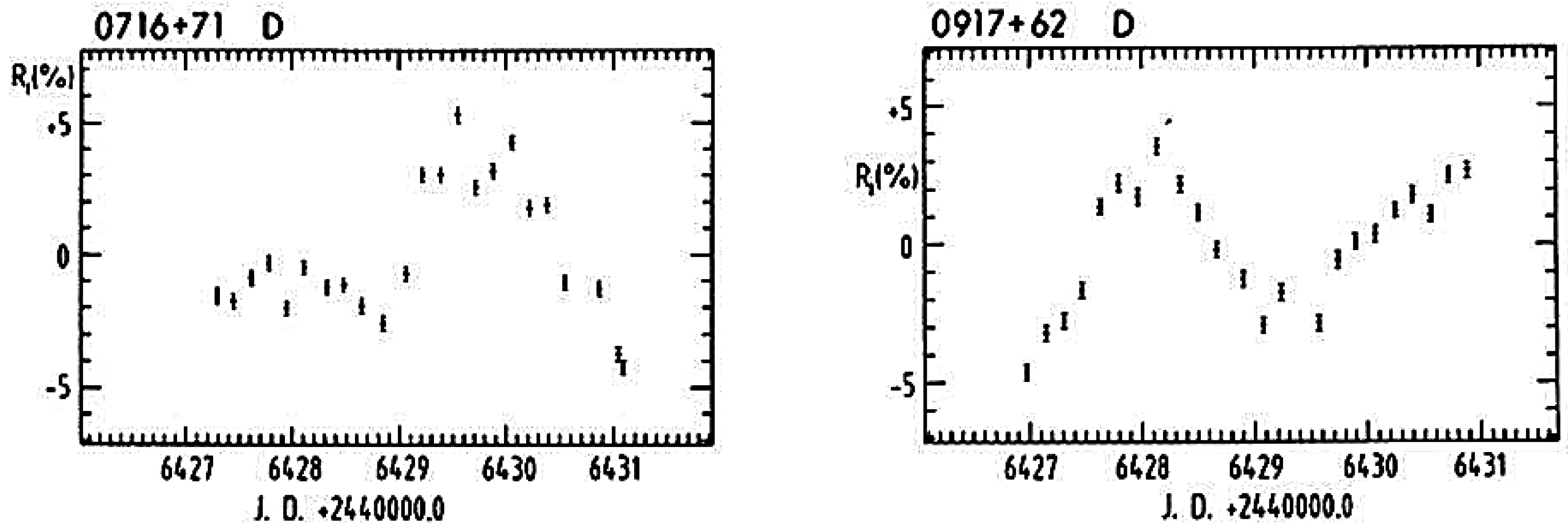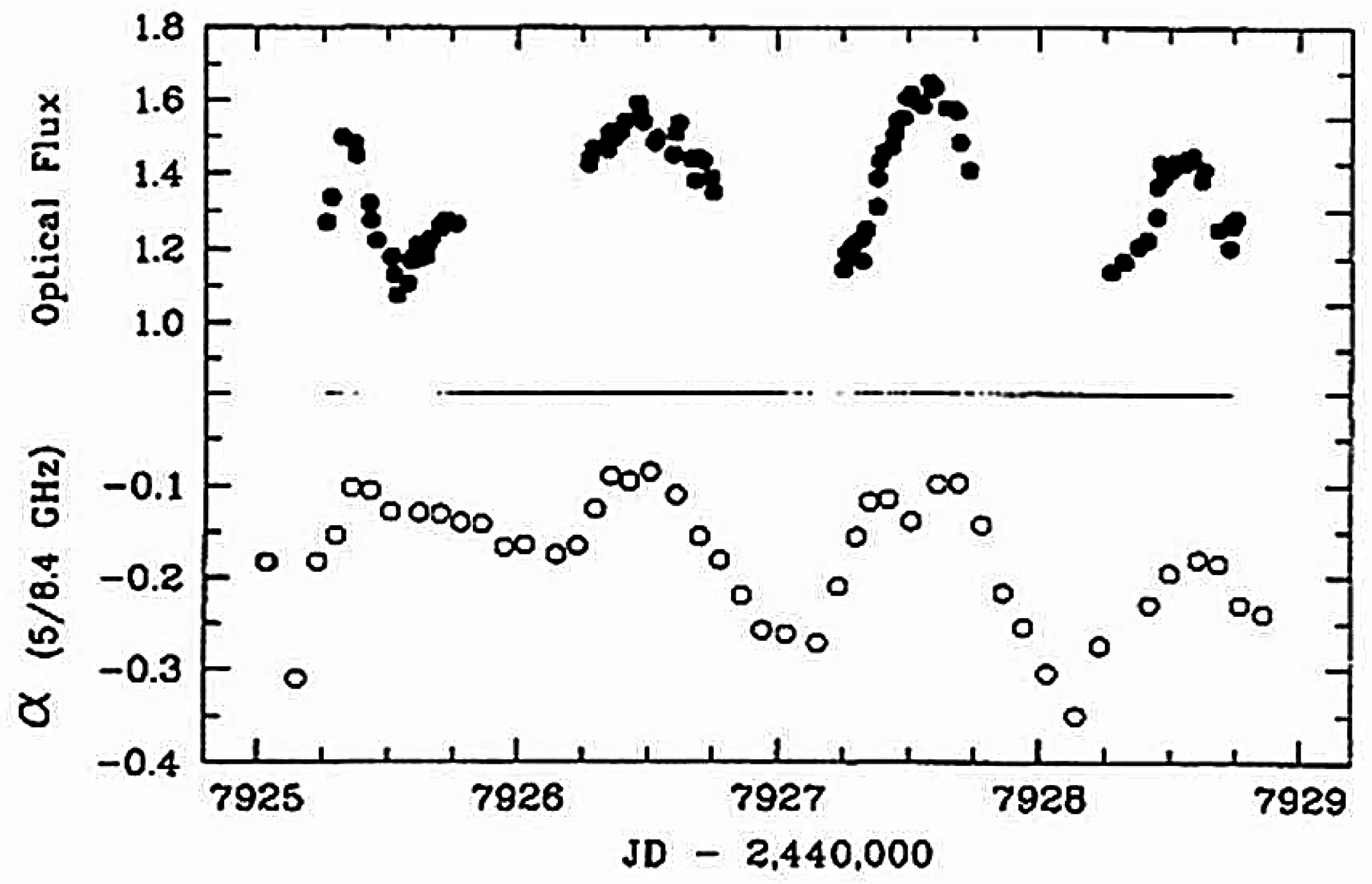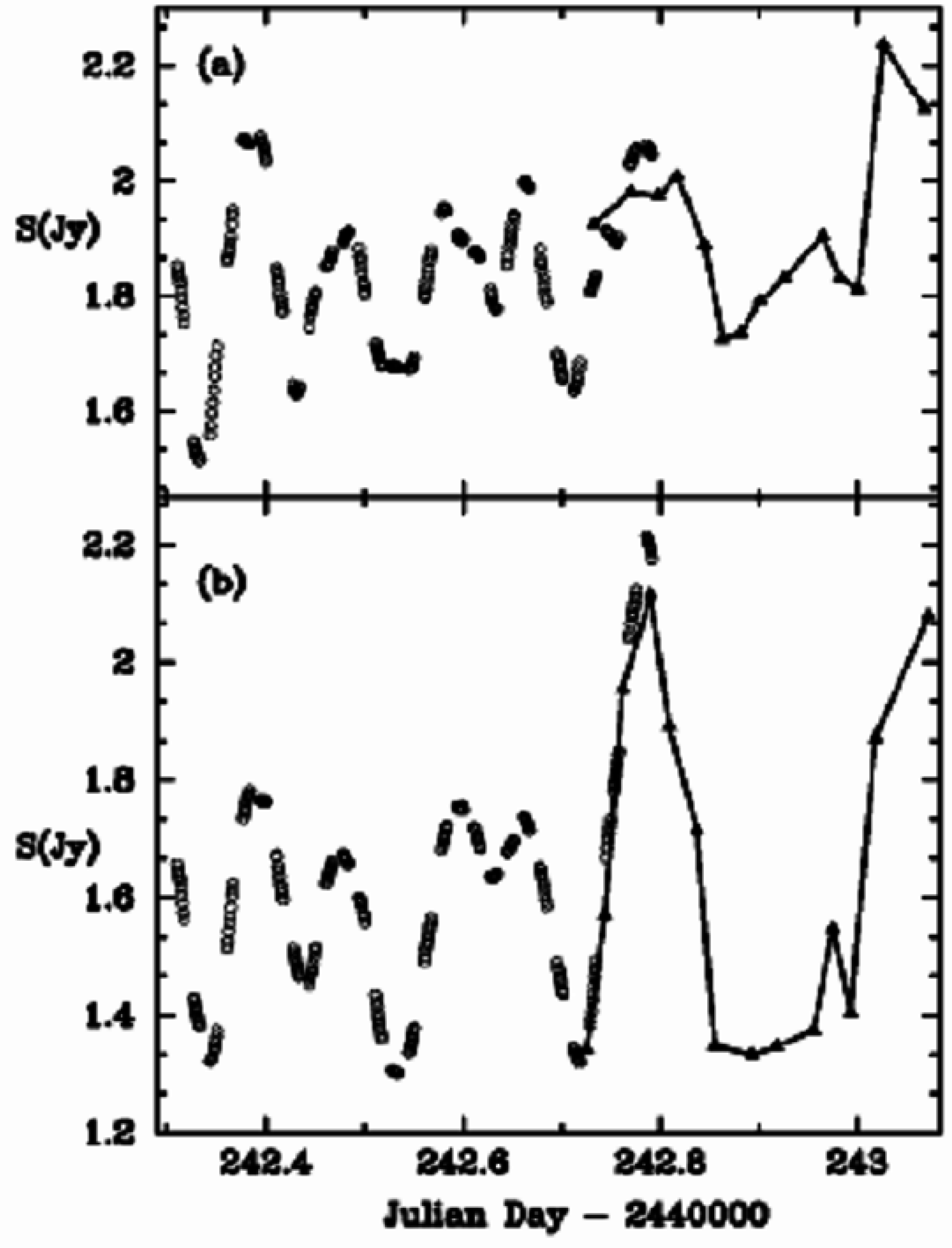Interstellar Scintillation and Scattering of Micro-arc-second AGN
Abstract
:1. 1965–1980s: Low Frequency Variability
2. 1980s–2002: Intra-Day Variability at Centimetre Wavelengths and Its Origin
3. 2002–Present: Statistical Studies and the Role of Interstellar Scattering
Acknowledgments
Author Contributions
Conflicts of Interest
References
- Schmidt, M. 3C 273: A Star-Like Object with Large Red-Shift. Nature 1963, 197, 1040. [Google Scholar] [CrossRef]
- Hazard, C.; Mackey, M.B.; Shimmins, A.J. Investigation of the Radio Source 3C 273 by the Method of Lunar Occultations. Nature 1963, 197, 1037–1039. [Google Scholar] [CrossRef]
- Smith, H.J. Light Variations of 3c 273. In Quasi-Stellar Sources and Gravitational Collapse; Robinson, I., Schild, A., Schucking, E.L., Eds.; University of Chicago Press: Chicago, IL, USA, 1965; p. 221. [Google Scholar]
- Dent, W.A. Quasi-Stellar Sources: Variation in the Radio Emission of 3C 273. Science 1965, 148, 1458–1460. [Google Scholar] [CrossRef] [PubMed]
- Sholomitsky, G.B. Variability of the Radio Source CTA-102. Inf. Bull. Var. Stars 1965, 83, 1. Available online: http://www.konkoly.hu/cgi-bin/IBVSpdf?0083 (accessed on 1 November 2016). [Google Scholar]
- Hunstead, R.W. Four variable radio sources at 408 MHz. Astrophys. Lett. 1972, 12, 193–200. [Google Scholar]
- Fanti, C.; Fanti, R.; Ficarra, A.; Mantovani, F.; Padrielli, L.; Weiler, K.W. Low Frequency Variable Sources 5-year Monitoring Program at 408-MHZ. Astron. Astrophys. Suppl. 1981, 45, 61. [Google Scholar]
- McAdam, W.B. Variable Sources at 408-MHZ. N. Z. J. Sci. 1979, 22, 343. [Google Scholar] [CrossRef]
- Rickett, B.J.; Coles, W.A.; Bourgois, G. Slow scintillation in the interstellar medium. Astron. Astrophys. 1984, 134, 390–395. [Google Scholar]
- Heeschen, D. Radio Flux Flicker of Extragalactic Sources. In Extragalactic Radio Sources; Heeschen, D.S., Wade, C.M., Eds.; Springer: Berlin, Germany, 1982; Volume 97, p. 327. [Google Scholar]
- Heeschen, D.S. Flickering of extragalactic radio sources. Astron. J. 1984, 89, 1111–1123. [Google Scholar] [CrossRef]
- Heeschen, D.S.; Rickett, B.J. The Galactic latitude dependence of centimeter-wavelength flicker. Astron. J. 1987, 93, 589–591. [Google Scholar] [CrossRef]
- Heeschen, D.S.; Krichbaum, T.; Schalinski, C.J.; Witzel, A. Rapid variability of extragalactic radio sources. Astron. J. 1987, 94, 1493–1507. [Google Scholar] [CrossRef]
- Quirrenbach, A.; Witzel, A.; Wagner, S.; Sanchez-Pons, F.; Krichbaum, T.P.; Wegner, R.; Anton, K.; Erkens, U.; Haehnelt, M.; Zensus, J.A.; et al. Correlated radio and optical variability in the BL Lacertae object 0716+714. Astrophys. J. 1991, 372, L71–L74. [Google Scholar] [CrossRef]
- Wagner, S.J.; Witzel, A. Intraday variability in quasars and BL Lac objects. Ann. Rev. Astron. Astrophys. 1995, 33, 163–198. [Google Scholar] [CrossRef]
- Readhead, A.C.S. Equipartition brightness temperature and the inverse Compton catastrophe. Astrophys. J. 1994, 426, 51–59. [Google Scholar] [CrossRef]
- Kedziora-Chudczer, L.; Jauncey, D.L.; Wieringa, M.H.; Walker, M.A.; Nicolson, G.D.; Reynolds, J.E.; Tzioumis, A.K. PKS 0405-385: The Smallest Radio Quasar? Astrophys. J. 1997, 490, L9–L12. [Google Scholar] [CrossRef]
- Biggs, A.D.; Browne, I.W.A.; Wilkinson, P.N. Intrinsic intraday variability in the gravitational lens system B0218+357. Mon. Not. R. Astron. Soc. 2001, 323, 995–998. [Google Scholar] [CrossRef]
- Martí-Vidal, I.; Muller, S. Using gravitationally lensed images to investigate the intrinsic AGN variability. Astron. Astrophys. 2016, 590, A83. [Google Scholar] [CrossRef]
- Jauncey, D.L.; Kedziora-Chudczer, L.L.; Lovell, J.E.J.; Nicolson, G.D.; Perley, R.A.; Reynolds, J.E.; Tzioumis, A.K.; Wieringa, M.H. The Origin of Intra-Day Variability. In Astrophysical Phenomena Revealed by Space VLBI; Hirabayashi, H., Edwards, P.G., Murphy, D.W., Eds.; Institute of Space and Astronautical Science: Tokyo, Japan, 2000; pp. 147–150. [Google Scholar]
- Dennett-Thorpe, J.; de Bruyn, A.G. The Discovery of a Microarcsecond Quasar: J1819+3845. Astrophys. J. 2000, 529, L65–L68. [Google Scholar] [CrossRef] [PubMed]
- Bignall, H.E.; Jauncey, D.L.; Lovell, J.E.J.; Tzioumis, A.K.; Kedziora-Chudczer, L.; Macquart, J.P.; Tingay, S.J.; Rayner, D.P.; Clay, R.W. Rapid Variability and Annual Cycles in the Characteristic Timescale of the Scintillating Source PKS 1257-326. Astrophys. J. 2003, 585, 653–664. [Google Scholar] [CrossRef]
- Dennett-Thorpe, J.; de Bruyn, A.G. Interstellar scintillation as the origin of the rapid radio variability of the quasar J1819+3845. Nature 2002, 415, 57–60. [Google Scholar] [CrossRef] [PubMed] [Green Version]
- Bignall, H.E.; Jauncey, D.L.; Lovell, J.E.J.; Kedziora-Chudczer, L.; Macquart, J.P.; Tzioumis, A.K.; Rickett, B.J.; Ojha, R.; Carter, S.; Cimó, G.; et al. Interstellar scintillation as a probe of microarcsecond scale structure in quasars. 2004; arXiv:astro-ph/0412650. [Google Scholar]
- Jauncey, D.L.; Bignall, H.E.; Lovell, J.E.J.; Kedziora-Chudczer, L.; Tzioumis, A.K.; Macquart, J.P.; Rickett, B.J. Interstellar Scintillation and Radio Intra-Day Variability. In Radio Astronomy at the Fringe; Zensus, J.A., Cohen, M.H., Ros, E., Eds.; Astronomical Society of the Pacific: San Francisco, CA, USA, 2003; Volume 300, p. 199. [Google Scholar]
- Dennett-Thorpe, J.; de Bruyn, A.G. Too hot, too fast or forever young? In Particles and Fields in Radio Galaxies; Laing, R.A., Blundell, K.M., Eds.; Astronomical Society of the Pacific: San Francisco, CA, USA, 2001; Volume 250, p. 133. [Google Scholar]
- Jauncey, D.L.; Macquart, J.P. Intra-day variability and the interstellar medium towards 0917+624. Astron. Astrophys. 2001, 370, L9–L12. [Google Scholar] [CrossRef]
- Rickett, B.J.; Witzel, A.; Kraus, A.; Krichbaum, T.P.; Qian, S.J. Annual Modulation in the Intraday Variability of Quasar 0917+624 due to Interstellar Scintillation. Astrophys. J. Lett. 2001, 550, L11–L14. [Google Scholar] [CrossRef]
- Kedziora-Chudczer, L. Long-term monitoring of the intra-day variable quasar PKS 0405-385. Mon. Not. R. Astron. Soc. 2006, 369, 449–464. [Google Scholar] [CrossRef]
- Bignall, H.E.; Macquart, J.P.; Jauncey, D.L.; Lovell, J.E.J.; Tzioumis, A.K.; Kedziora-Chudczer, L. Rapid Interstellar Scintillation of PKS 1257-326: Two-Station Pattern Time Delays and Constraints on Scattering and Microarcsecond Source Structure. Astrophys. J. 2006, 652, 1050–1058. [Google Scholar] [CrossRef]
- Jauncey, D.L.; Johnston, H.M.; Bignall, H.E.; Lovell, J.E.J.; Kedziora-Chudczer, L.; Tzioumis, A.K.; Macquart, J.P. Interstellar Scintillation and Annual Cycles in the BL Lac Source PKS 1519-273. Astrophys. Sapce Sci. 2003, 288, 63–68. [Google Scholar] [CrossRef]
- Linsky, J.L.; Rickett, B.J.; Redfield, S. The Origin of Radio Scintillation in the Local Interstellar Medium. Astrophys. J. 2008, 675, 413–419. [Google Scholar] [CrossRef]
- Lovell, J.E.J.; Jauncey, D.L.; Bignall, H.E.; Kedziora-Chudczer, L.; Macquart, J.P.; Rickett, B.J.; Tzioumis, A.K. First Results from MASIV: The Microarcsecond Scintillation-induced Variability Survey. Astron. J. 2003, 126, 1699–1706. [Google Scholar] [CrossRef]
- Pursimo, T.; Ojha, R.; Jauncey, D.; Lovell, J.; Dutka, M.; Bignall, H.; Macquart, J.P.; Rickett, B.; Kedziora-Chudczer, L.; Koay, J.Y. The MASIV survey: Spectroscopic identifications of compact radio sources. In Multiwavelength AGN Surveys and Studies; Mickaelian, A.M., Sanders, D.B., Eds.; The International Astronomical Union: Paris, France, 2014; pp. 110–111. [Google Scholar]
- Lovell, J.E.J.; Rickett, B.J.; Macquart, J.P.; Jauncey, D.L.; Bignall, H.E.; Kedziora-Chudczer, L.; Ojha, R.; Pursimo, T.; Dutka, M.; Senkbeil, C.; et al. The Micro-Arcsecond Scintillation-Induced Variability (MASIV) Survey. II. The First Four Epochs. Astrophys. J. 2008, 689, 108–126. [Google Scholar] [CrossRef]
- Haffner, L.M.; Reynolds, R.J.; Tufte, S.L.; Madsen, G.J.; Jaehnig, K.P.; Percival, J.W. The Wisconsin Hα Mapper Northern Sky Survey. Astrophys. J. Suppl. 2003, 149, 405–422. [Google Scholar] [CrossRef]
- Pushkarev, A.B.; Kovalev, Y.Y. Milky Way scattering properties and intrinsic sizes of active galactic nuclei cores probed by very long baseline interferometry surveys of compact extragalactic radio sources. Mon. Not. R. Astron. Soc. 2015, 452, 4274–4282. [Google Scholar] [CrossRef]
- Rickett, B.J.; Lazio, T.J.W.; Ghigo, F.D. Interstellar Scintillation Observations of 146 Extragalactic Radio Sources. Astrophys. J. Suppl. 2006, 165, 439–460. [Google Scholar] [CrossRef]
- McCallum, J.N.; Ellingsen, S.P.; Jauncey, D.L.; Lovell, J.E.J.; Greenhill, L.J. Scintillation in the Circinus Galaxy H2O Megamasers. Astron. J. 2005, 129, 1231–1236. [Google Scholar] [CrossRef]
- Ojha, R.; Fey, A.L.; Jauncey, D.L.; Lovell, J.E.J.; Johnston, K.J. Milliarcsecond Structure of Microarcsecond Sources: Comparison of Scintillating and Nonscintillating Extragalactic Radio Sources. Astrophys. J. 2004, 614, 607–614. [Google Scholar] [CrossRef]
- Ojha, R.; Fey, A.L.; Lazio, T.J.W.; Jauncey, D.L.; Lovell, J.E.J.; Kedziora-Chudczer, L. Scatter Broadening of Scintillating and Nonscintillating AGNs. I. A Multifrequency VLBA Survey. Astrophys. J. Suppl. 2006, 166, 37–68. [Google Scholar] [CrossRef]
- Lazio, T.J.W.; Ojha, R.; Fey, A.L.; Kedziora-Chudczer, L.; Cordes, J.M.; Jauncey, D.L.; Lovell, J.E.J. Angular Broadening of Intraday Variable AGNs. II. Interstellar and Intergalactic Scattering. Astrophys. J. 2008, 672, 115–121. [Google Scholar] [CrossRef]
- Koay, J.Y.; Macquart, J.P.; Rickett, B.J.; Bignall, H.E.; Jauncey, D.L.; Pursimo, T.; Reynolds, C.; Lovell, J.E.J.; Kedziora-Chudczer, L.; Ojha, R. Why Do Compact Active Galactic Nuclei at High Redshift Scintillate Less? Astrophys. J. 2012, 756, 29. [Google Scholar] [CrossRef]
- Liu, X.; Song, H.G.; Marchili, N.; Liu, B.R.; Liu, J.; Krichbaum, T.P.; Fuhrmann, L.; Zensus, J.A. Intra-day variability observations of S5 0716+714 over 4.5 years at 4.8 GHz. Astron. Astrophys. 2012, 543, A78. [Google Scholar] [CrossRef]
- Quirrenbach, A.; Kraus, A.; Witzel, A.; Zensus, J.A.; Peng, B.; Risse, M.; Krichbaum, T.P.; Wegner, R.; Naundorf, C.E. Intraday variability in compact extragalactic radio sources. I. VLA observations. Astron. Astrophys. Suppl. 2000, 141, 221–256. [Google Scholar] [CrossRef]





© 2016 by the authors; licensee MDPI, Basel, Switzerland. This article is an open access article distributed under the terms and conditions of the Creative Commons Attribution (CC-BY) license (http://creativecommons.org/licenses/by/4.0/).
Share and Cite
Jauncey, D.L.; Bignall, H.E.; Kedziora-Chudczer, L.; Koay, J.Y.; Lovell, J.E.J.; Macquart, J.-P.; Ojha, R.; Pursimo, T.; Reynolds, C.; Rickett, B.J. Interstellar Scintillation and Scattering of Micro-arc-second AGN. Galaxies 2016, 4, 62. https://doi.org/10.3390/galaxies4040062
Jauncey DL, Bignall HE, Kedziora-Chudczer L, Koay JY, Lovell JEJ, Macquart J-P, Ojha R, Pursimo T, Reynolds C, Rickett BJ. Interstellar Scintillation and Scattering of Micro-arc-second AGN. Galaxies. 2016; 4(4):62. https://doi.org/10.3390/galaxies4040062
Chicago/Turabian StyleJauncey, David L., Hayley E. Bignall, Lucyna Kedziora-Chudczer, Jun Yi Koay, James E. J. Lovell, Jean-Pierre Macquart, Roopesh Ojha, Tapio Pursimo, Cormac Reynolds, and Barney J. Rickett. 2016. "Interstellar Scintillation and Scattering of Micro-arc-second AGN" Galaxies 4, no. 4: 62. https://doi.org/10.3390/galaxies4040062





